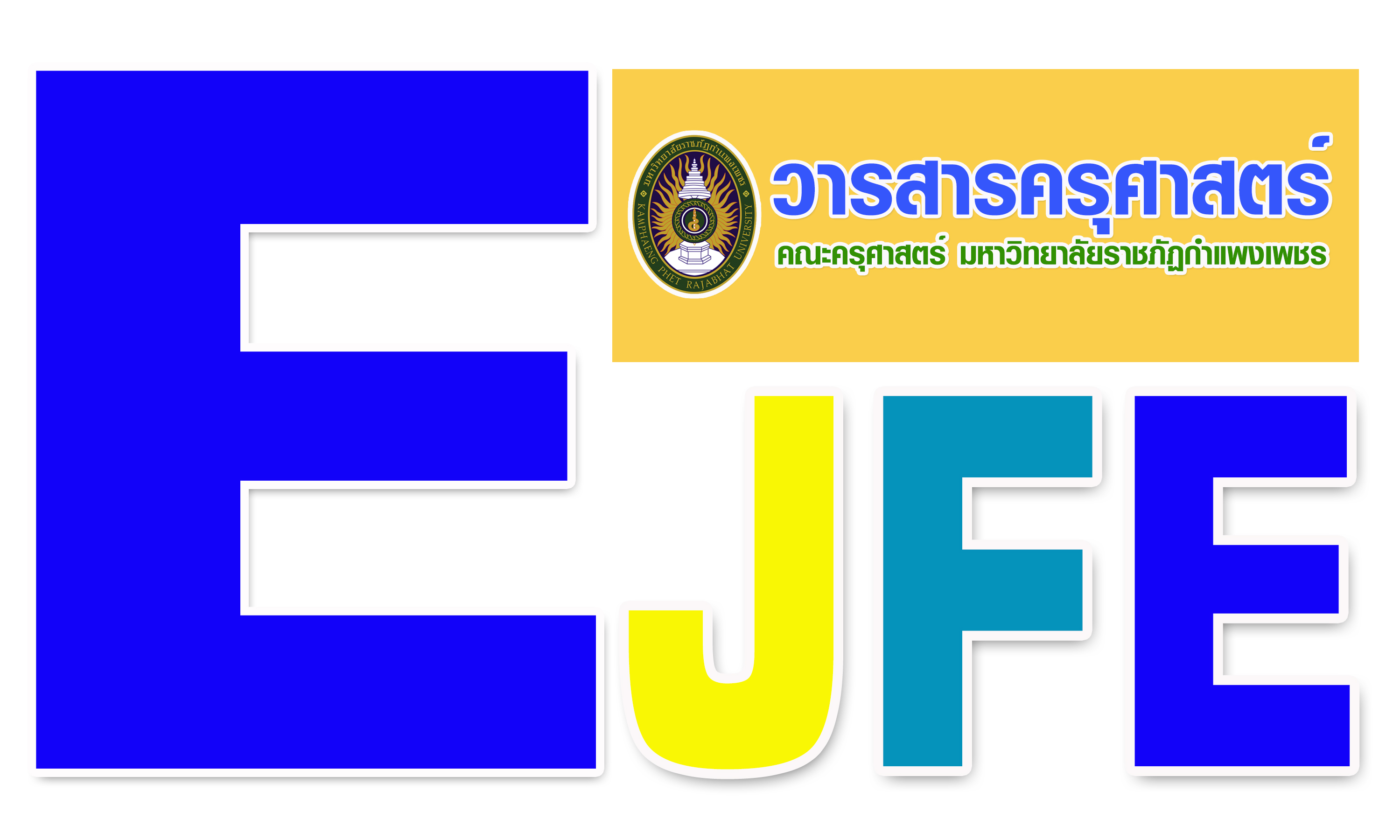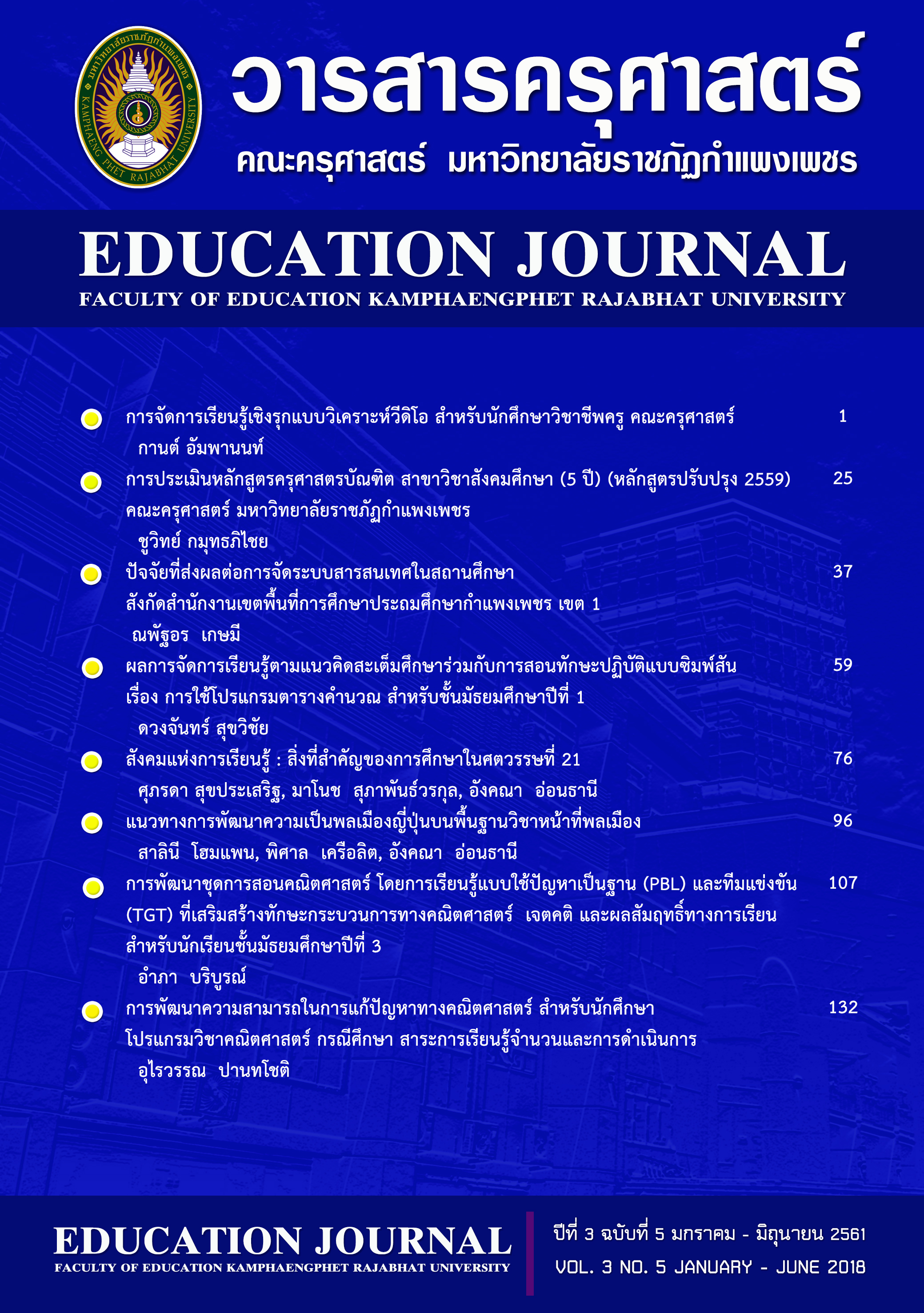THE ACTIVE LEARNING MANAGEMENT THROUGH VIDEO ANALYSIS FOR TEACHING PROFESSION STUDENTS OF THE FACULTY OF EDUCATION
Main Article Content
Abstract
This paper aims at introducing conceptual frameworks and practice of an active learning management through video analysis with the intention of developing teaching profession students of the faculty of education to attain higher order thinking skills relating to 21st century as well as promoting students to acquire thinking skills, analytical skills, group work skills, and problem-solving skills. The active learning is one of the teaching methods that appropriate to the learning that aims to create understandings and apply knowledge to everyday life. It encourages students to be active in their learning and eager to think. Accordingly, the active learning plays an important role in promoting students’ learning outcome. The teachers’ roles has changed and become the learning designer and the facilitator in the learning management. Students, however, will have to actively participate in the learning activities and learn by doing in order to support them to gain higher order thinking skills and the competency that meet the needs of the changing world and the advancement of the 21st century. Furthermore, the active learning management can help students to attain knowledge skills, cognitive skills, responsibility and interpersonal skills, numerical analytic skills, and communication and technology skills. Therefore, providing experiences to students of education faculty may lead them to manage the active learning that promote higher order thinking skills at schools which is regarded as one of the characteristics of the learners of the 21st century.
Managing the active learning through video analysis can make students pay more attention to the lessons. Also, the students involve in expressing ideas, analyzing, synthesizing, reflecting what they have learned, or exploring information from the situations derived from the videos. This is considered to be the teaching method that needs both the interaction between teacher and students and among students as well. The purposes are to share ideas in the group, to widen their horizon of viewpoints as well as to find diverse solutions for problem solving. Consequently, the students will have thoughtful ideas, know how to do the action plans, and the students’ capacity will be naturally enhanced at their own pace.
Article Details

This work is licensed under a Creative Commons Attribution-NonCommercial 4.0 International License.
CC Attribution-NonCommercial-NoDerivatives 4.0
References
กระทรวงศึกษาธิการ. (2545). พระราชบัญญัติการศึกษาแห่งชาติ พ.ศ. 2542 แก้ไขเพิ่มเติม(ฉบับที่2) พ.ศ. 2545. กรุงเทพฯ: คุรุสภา.
กมลฉัตร กล่อมอิ่ม. (2559). “การจัดการเรียนรู้แบบบูรณาการสะเต็มศึกษา สำหรับนักศึกษาวิชาชีพครู” ใน วารสารศึกษาศาสตร์. ปีที่ 18 (4), หน้า 336.
กานต์ อัมพานนท์. (2559). การศึกษาการจัดการศึกษาวิชาความเป็นครูในศตวรรษที่ 21 คณะครุศาสตร์ กลุ่มมหาวิทยาลัยราชภัฎภาคเหนือ. รายงานการวิจัย, มหาวิทยาลัยราชภัฏเพชรบูรณ์.
กานต์ อัมพานนท์. (2560). การพัฒนารูปแบบการเรียนรู้เชิงรุกที่ส่งเสริมทักษะการคิด สำหรับนักศึกษาคณะครุศาสตร์ มหาวิทยาลัยราชภัฏเพชรบูรณ์. รายงานการวิจัย, มหาวิทยาลัยราชภัฏเพชรบูรณ์.
ขวัญชัย ดวงทนัน. (2557). การใช้ชุดสื่อการสอนการจัดทำสื่อวีดิโอช่วยสอนเรื่อง การควบคุมคุณภาพสำหรับเป็นสื่อช่วยสอนในกระบวนวิชาการพัฒนางานด้วยระบบคุณภาพและเพิ่มผลผลิตตามหลักสูตรประกาศนียบัตรวิชาชีพ วิทยาลัยเทคโนโลยีโปลิเทคนิคล้านนา. ศึกษาศาสตรมหาบัณฑิต (อาชีวศึกษา), มหาวิทยาลัยเชียงใหม่.
เกรียงศักดิ์ เจริญวงศ์ศักดิ์. (2557). การคิดสร้างสรรค์. (พิมพ์ครั้งที่ 10). กรุงเทพฯ: ซั่คเซสมีเดีย.
ชนาธิป พรกุล. (2559). แคทส์: รูปแบบการจัดการเรียนการสอนที่ผู้เรียนเป็นศูนย์กลาง. (พิมพ์ครั้งที่ 9). กรุงเทพฯ: โรงพิมพ์แห่งจุฬาลงกรณ์มหาวิทยาลัย.
ชัยวัฒน์ สุทธิรัตน์. (2558). 80 นวัตกรรมการเรียนรู้ทีเน้นผู้เรียนเป็นสำคัญ. (พิมพ์ครั้งที่ 8). กรุงเทพฯ: วี พรินท์ (1991).
ทิศนา แขมมณี. (2558). ศาสตร์การสอน:องค์ความรู้เพื่อการจัดกระบวนการเรียนรู้ที่มีประสิทธิภาพ. (พิมพ์ครั้งที่ 15). กรุงเทพฯ: โรงพิมพ์แห่งจุฬาลงกรณ์มหาวิทยาลัย.
ปรียา สมพืช. (2559). “การจัดการเรียนรู้เชิงรุกโดยใช้รูปแบบการเรียนการสอนด้วยกรณีศึกษา”ในวารสารวิจัยราชภัฏพระนคร สาขามนุษยศาสตร์และสังคมศาสตร์. ปีที่ 11 (2), หน้า 262 – 268.
พิมพันธ์ เดชะคุปต์. (2557). การสร้างบรรยากาศในการเรียนการสอนที่เน้นผู้เรียนเป็นสำคัญในการเรียนการสอนที่เน้นผู้เรียนเป็นสำคัญ: แนวคิด วิธี และเทคนิคการสอน. กรุงเทพฯ:เดอะมาสเตอร์กรุ๊ปแมนเนจเมนท์.
ไพฑูรย์ สินลารัตน์. (2557). ยุทธศาสตร์การสอนตามกรอบมาตรฐานคุณวุฒิระดับอุดมศึกษา. (พิมพ์ครั้งที่ 10). กรุงเทพฯ: โรงพิมพ์แห่งจุฬาลงกรณ์มหาวิทยาลัย.
วิจารณ์ พานิช. (2558). วิถีสร้างการเรียนรู้เพื่อศิษย์ในศตวรรษที่21. (พิมพ์ครั้งที่ 10). กรุงเทพฯ: โรงพิมพ์แห่งจุฬาลงกรณ์มหาวิทยาลัย.
สรวงพร กุศลส่ง. (2558). การพัฒนารูปแบบการเรียนการสอนที่ส่งเสริมยุทธวิธีการรู้คิดสำหรับนักศึกษามหาวิทยาลัยราชภัฏ. วิทยานิพนธ์ครุศาสตรดุษฎีบัณฑิต (หลักสูตรและการสอน), มหาวิทยาลัยนเรศวร.
สุกัญญา งามบรรจง. (2559). การพัฒนารูปแบบการจัดกระบวนการเรียนรู้เพื่อเสริมสร้างทักษะในศตวรรษที่ 21. รายงานการวิจัย. สำนักงานคณะกรรมการการศึกษาขั้นพื้นฐาน.
สุวิทย์ มูลคำ. (2558). Child Center Storyline Method: การบูรณาการหลักสูตรและการเรียน การสอนโดยเน้นผู้เรียนเป็นศูนย์กลาง. กรุงเทพฯ: ที .พี. พริ้นท์.
สุนิสา จันทร์เลขา. (2551). การพัฒนาผลสัมฤทธิ์ทางการเรียนเรื่องสื่อประสมผลิตภัณฑ์ของนักศึกษาระดับอนุปริญญาวิทยาลัยชุมชนสระแก้ว ด้วยการสอนโดยใช้สื่อวีดีทัศน์. รายงานการวิจัย. วิทยาลัยชุมชนสระแก้ว.
สำนักงานคณะกรรมการการอุดมศึกษา. (2552). กรอบมาตรฐานคุณวุฒิระดับอุดมศึกษาแห่งชาติ พ.ศ. 2552 และแนวปฏิบัติ. สำนักงานคณะกรรมการการอุดมศึกษา, กรุงเทพฯ.
Armstrong, T. (2006). Multiple Intelligences: Seven Ways to Approach Curriculum Educational Leadership. New York: Prentice-Hall.
Benjamin S. Bloom (2008). Taxonomy of Educational Objectives. Handbook II: Affective Domain. New York: Mckay.
Cratty, B.J. (2014). Active Learning. Houghton: Miffin Company.
De Bono, E. (1992). Six Thinking Hats for Schools. Cheltenham, Vic.: Hawker Brownlow Education.
Flavell, J.H. (1985). Cognitive Developmental. New Jersey: Prentice-Hall.
Gredler, M. E. (2014). Active Learning and Instruction: Theory into Practice. (3rd). New Jersey: Prentice-Hall.
John, J. Dewey. (1959). Experience and Education. New York: Macmillan.
Joyce, B., & Weil, M. (1972). Models of Teaching. Englewood Cliffs, N.J.: Prentice-Hall.
Khan, B. H. (2014). Active Learning in the Features. New York: Van Nor strand.
LikLorenzen, M. (2014). Active Learning. Singapore: McGraw–Hill.
Piaget, J. (2001). The Child's Conception of Physical Casualty. New Brunswick, N.J.: Adams Co.


